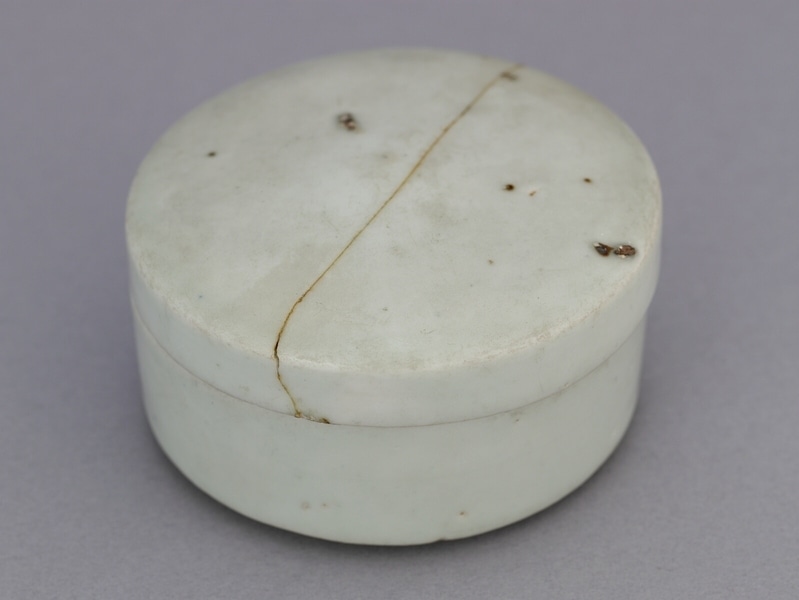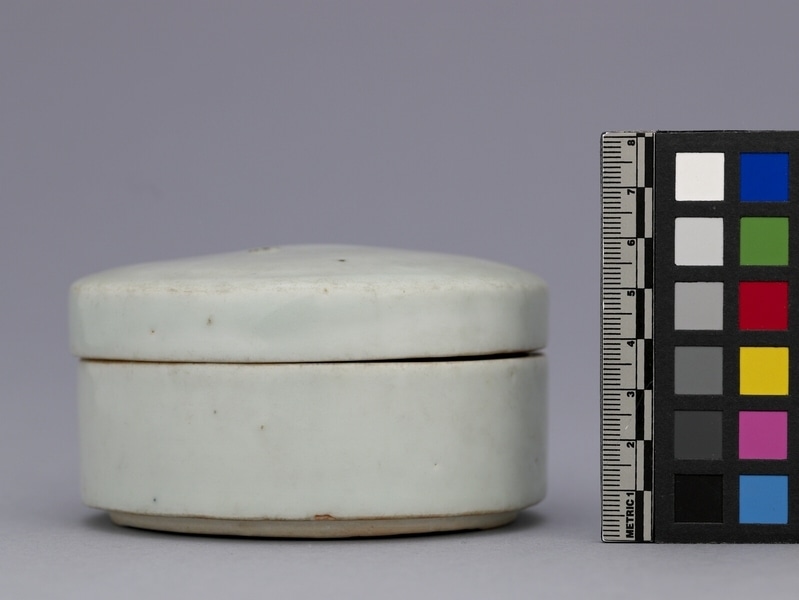Box Item Number: Ia282 a-b from the MOA: University of British Columbia



Description
Round covered box with straight sides. The lid has a slightly convex top. The lid is just slightly larger in outside diameter than the body. There is no ridge on the lid or body onto which the lid can sit. It has a low foot. The body is covered with a grey-blue glaze except for the foot, base, top rim of body and rim of lid. These unglazed areas are fired a buff colour and where the glaze ends is a clear line of orange. There are dark spots on the lid where grit has stuck. Inked letter and number on the underside.
History Of Use
Chinese ceramics were important trade items in southeast Asia during the 11th-16th centuries and became fully integrated with ideology and ritual in Philippine societies, playing an important role in all aspects of cultural life (Langrick, p.61). Their functions were varied and included utilitarian, ceremonial and religious roles as heirlooms, and in mortuary ceremonies as burial goods and items of prestige. Chinese ceramics constitute the vast majority of burial goods excavated in the Philippines. Buried with the deceased, they acted as indicators of wealth, protected the departing spirit from evil and serving as provisions for the afterlife. Turned-over plates and bowls were used to cover certain parts of the body, establishing a protective area. In addition, many excavated ceramics were miniaturized replicas of larger, functional vessels--symbolic substitutes for provisions for the afterlife. In addition, small jarlets and bottles and other containers were used for ritual substances (oils, herbs, aromatic resins) and for food offerings necessary for the departing spirit. Most of the trade ceramics excavated in the Philippines show little or no evidence of usage before burial. According to Medley, Ding ware was made from sometime in the second half of the 10th century through the Song (960-1279) and Yuan (1260-1368) dynasties, and perhaps later. The name derives from Ding-Zhou in north China where it was first produced. From the condition of trade ceramics shown in published sources and the Tecson collection, it appears that most of the wares were kiln seconds, or rejects. They were nevertheless regarded with high esteem and actively traded.
Cultural Context
exchange; status; ceremonial; mortuary
Narrative
This box is part of a collection of Chinese ceramics found in burial context in the Philippines and was excavated at a burial site in Lumban, Laguna Province, Philippines. Repairs were done by specialists employed by archaeologists and the Philippines National Museum. They were artists by training.
Specific Techniques
It is probable that the lid and body had been sliced apart.
Iconographic Meaning
In many indigenous groups of the Philippines, supernatural power was attributed to Chinese ceramics because of the ringing sound emitted when lightly tapped and their vitreous, shiny glazed surfaces which impart an impermeable quality. The ringing sound was seen as a magical voice able to attract the attention of powerful ancestor spirits. Their impermeable and seemingly imperishable surfaces were believed to have great protective power against all kinds of influences, from evil spirits to poisons (Langrick, p. 55-56).
Item History
- Made in Lumban, Laguna, Philippines between 960 and 1279
- Owned by Julia Tecson and Miguel Tecson before November 16, 1987
- Received from Julia Tecson (Donor) and Miguel Tecson (Donor) on November 16, 1987
What
Who
- Culture
- Philippines
- Previous Owner
- Julia Tecson and Miguel Tecson
- Received from
- Julia Tecson (Donor) and Miguel Tecson (Donor)
Where
- Holding Institution
- MOA: University of British Columbia
- Made in
- Lumban, Laguna, Philippines
When
- Creation Date
- between 960 and 1279
- Ownership Date
- before November 16, 1987
- Acquisition Date
- on November 16, 1987
Other
- Item Classes
- ceramics
- Condition
- good
- Accession Number
- 1262/0064 a-b